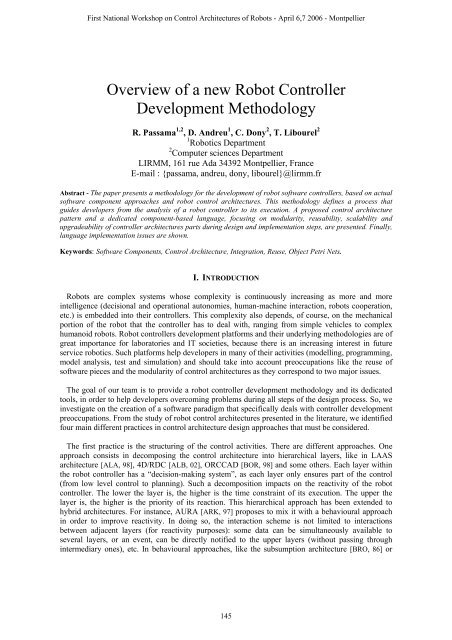Pleading for open modular architectures - Lirmm
Pleading for open modular architectures - Lirmm
Pleading for open modular architectures - Lirmm
Create successful ePaper yourself
Turn your PDF publications into a flip-book with our unique Google optimized e-Paper software.
First National Workshop on Control Architectures of Robots - April 6,7 2006 - Montpellier<br />
Overview of a new Robot Controller<br />
Development Methodology<br />
R. Passama 1,2 , D. Andreu 1 , C. Dony 2 , T. Libourel 2<br />
1 Robotics Department<br />
2 Computer sciences Department<br />
LIRMM, 161 rue Ada 34392 Montpellier, France<br />
E-mail : {passama, andreu, dony, libourel}@lirmm.fr<br />
Abstract - The paper presents a methodology <strong>for</strong> the development of robot software controllers, based on actual<br />
software component approaches and robot control <strong>architectures</strong>. This methodology defines a process that<br />
guides developers from the analysis of a robot controller to its execution. A proposed control architecture<br />
pattern and a dedicated component-based language, focusing on <strong>modular</strong>ity, reusability, scalability and<br />
upgradeability of controller <strong>architectures</strong> parts during design and implementation steps, are presented. Finally,<br />
language implementation issues are shown.<br />
Keywords: Software Components, Control Architecture, Integration, Reuse, Object Petri Nets.<br />
I. INTRODUCTION<br />
Robots are complex systems whose complexity is continuously increasing as more and more<br />
intelligence (decisional and operational autonomies, human-machine interaction, robots cooperation,<br />
etc.) is embedded into their controllers. This complexity also depends, of course, on the mechanical<br />
portion of the robot that the controller has to deal with, ranging from simple vehicles to complex<br />
humanoid robots. Robot controllers development plat<strong>for</strong>ms and their underlying methodologies are of<br />
great importance <strong>for</strong> laboratories and IT societies, because there is an increasing interest in future<br />
service robotics. Such plat<strong>for</strong>ms help developers in many of their activities (modelling, programming,<br />
model analysis, test and simulation) and should take into account preoccupations like the reuse of<br />
software pieces and the <strong>modular</strong>ity of control <strong>architectures</strong> as they correspond to two major issues.<br />
The goal of our team is to provide a robot controller development methodology and its dedicated<br />
tools, in order to help developers overcoming problems during all steps of the design process. So, we<br />
investigate on the creation of a software paradigm that specifically deals with controller development<br />
preoccupations. From the study of robot control <strong>architectures</strong> presented in the literature, we identified<br />
four main different practices in control architecture design approaches that must be considered.<br />
The first practice is the structuring of the control activities. There are different approaches. One<br />
approach consists in decomposing the control architecture into hierarchical layers, like in LAAS<br />
architecture [ALA, 98], 4D/RDC [ALB, 02], ORCCAD [BOR, 98] and some others. Each layer within<br />
the robot controller has a “decision-making system”, as each layer only ensures part of the control<br />
(from low level control to planning). Such a decomposition impacts on the reactivity of the robot<br />
controller. The lower the layer is, the higher is the time constraint of its execution. The upper the<br />
layer is, the higher is the priority of its reaction. This hierarchical approach has been extended to<br />
hybrid <strong>architectures</strong>. For instance, AURA [ARK, 97] proposes to mix it with a behavioural approach<br />
in order to improve reactivity. In doing so, the interaction scheme is not limited to interactions<br />
between adjacent layers (<strong>for</strong> reactivity purposes): some data can be simultaneously available to<br />
several layers, or an event, can be directly notified to the upper layers (without passing through<br />
intermediary ones), etc. In behavioural approaches, like the subsumption architecture [BRO, 86] or<br />
145

















